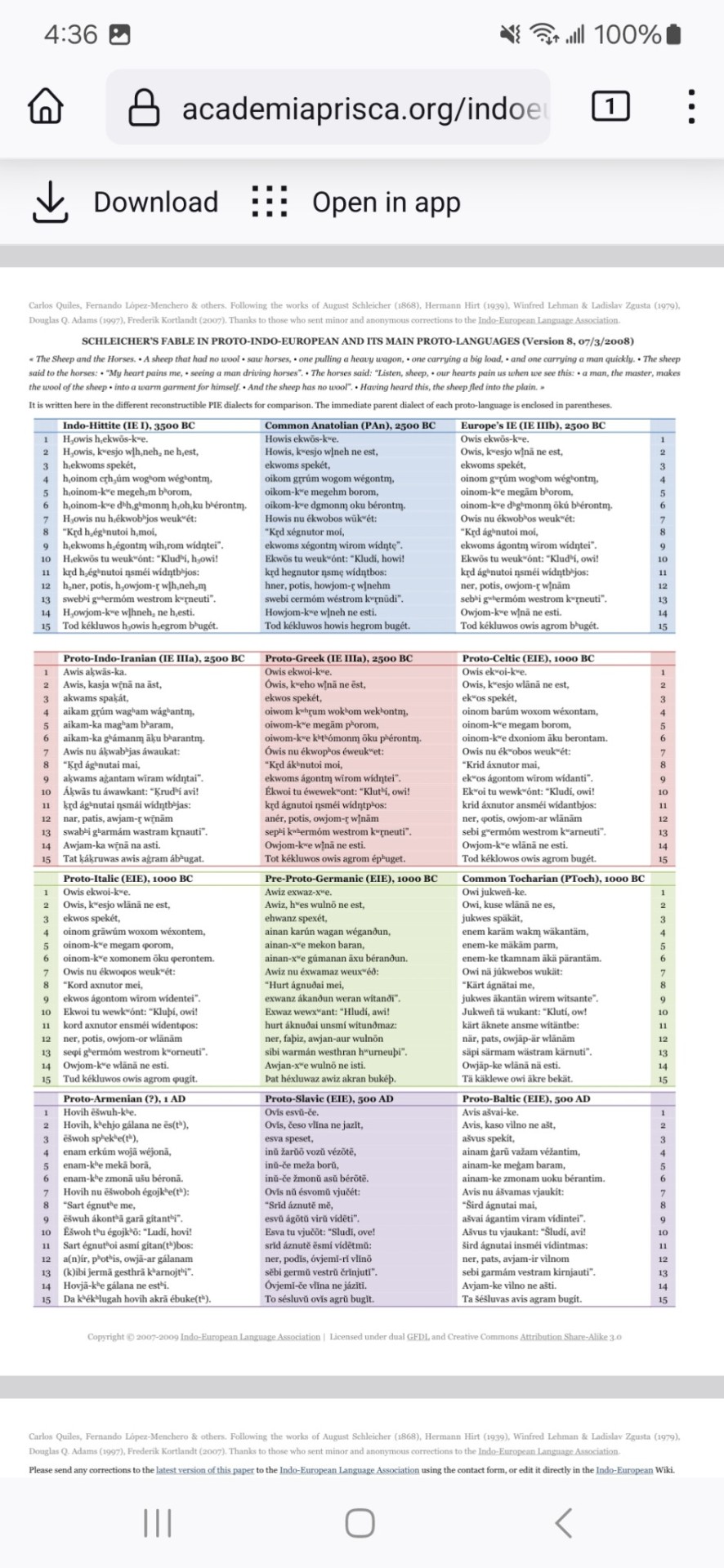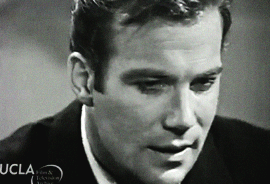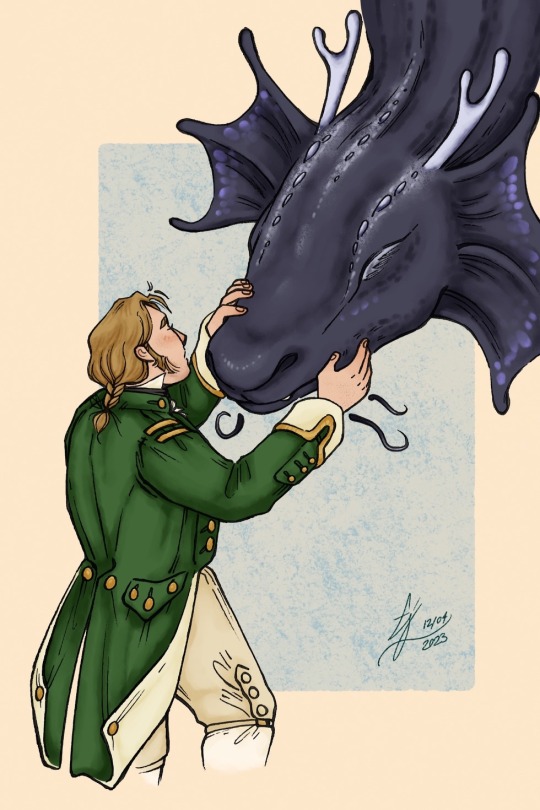#proto language
Explore tagged Tumblr posts
Text
If there are any linguistics professionals reading this, I could use some help.
I'm doing research into Proto-Indo-European, the mother tongue of much of Europe and South Asia, and I recently discovered Schleicher's Fable, a short story about sheep and horses which has been translated into a dozen proto-languages to show how different branches envolved over the millennia.

My problem is that I don't know the word order or declensions (suffixes for different conjugations) of any of these languages, so I have no idea which words mean what throughout the text.
I know owis/hovis/avis means sheep (same etymology as modern English "ewe")
Ekwos means horse (equus, equestrian, etc.)
Wlna/wlana/vilno means wool
Oinom/aikam/enem means one
Krd/kart/sird means heart (cardio)
Widntei/widntbhos means see/seeing/sight (video/visual)
I think agnutai/egnutoi means hurt or pain (agony) but I don't know for sure
Same with megehm/megam for big (presumably like mega/magnum)
I can recognize a handful of other words from context, but some sentences completely confuse me. The phrase "heavy wagon" appears to be "woghom wegontm," both words of which look like they possibly share the same root, but I don't know which means heavy and which means wagon. All the variations of "dgmonm oku bherontm" mean "carry a man quickly," but I don't know which words corresponds to carry, man, or quickly. I think bherontm means carry because it has the -ontm suffix which I think marks a verb, but again, I just don't know.
I don't know the words for "the master makes the wool of the sheep into a warm garment for himself" or "the sheep fled into the plain." It's helpful that the story is broken down into lines, but it doesn't explain what each individual word means in order, so I don't know the proper translation.
Does anyone know where I can find an in depth breakdown of Schleicher's Fable with every word and declension annotated? I've tried looking up Proto-Indo-European glossaries/dictionaries online, but every corpus spells the words differently (lots of subscript letters and numbers and asterisks), some words have multiple PIE translations and no two sites agree on which to use when. It's not helpful at all.
I need a word-by-word translation, something like:
PIE: owis kwesjo wlna na est ekwoms speket
Literal: sheep which wool no have horses saw
English: a sheep which had no wool saw horses
Does anyone know where I can find the proper resources for this project?
#help me tumblr#linguistics#proto indo european#pie#proto language#schleicher's fable#the sheep and the horses#etymology#history#translation#dead languages#indo european#languages
44 notes
·
View notes
Text
Alright, time to build the language.
Let's play around with word order after figuring some other stuff out first, although I'm leaning towards OSV right now. Let's just remind ourselves the system we're working with
Subject Object Verb Link
The Creator stood upon the mountain and overlooked a frozen land. This is how it was in the beginning.
I'll be going with Active-Stative alignment, so S¹=A and S²=P, perhaps going with agentive-default fluid-S, so this would mean that S¹=A will be unmarked, as it is assumed the default position, where S²=P will be marked, as it is a change to the default. Nouns will have a Agentive and Patientive form as a result, with the Patientive Sole being marked like the Patient. But languages aren't strict rule followers, they have exceptions. I could imagine there being exceptions to the rule, such as a Locative being marked in both Agentive and Patientive cases, depending on which one is being x'd on. Speaking of cases, I think I'll go with Genitive (GEN - attributive relationship between two nouns), Dative (DAT - marks the recipient of an action), Locative (LOC - indicates location in relation to another noun), and Instrumental (INS - something being used by another noun) cases. For the locative case, the specifics of in, on, under, &c. is inferred but helper words could be used.

And here's the rule for adpositions:
Prepositional - Demonstrative, numeral, adjectives, comes after the noun, possessive, genitive, and relative come before the noun
Quantity > Opinion > Size > Age > Shape > Color > Origin > Material > Purpose > Noun seems perfectly fine to me, I guess I could change some just to change some. Could order them by objectivity I suppose. I could go objective to subjective
Quantity > Material > Size > Shape > Origin > Age > Color > Purpose > Opinion > Noun
Or the reverse
Opinion > Purpose > Color > Age > Origin > Shape > Size > Material > Quantity > Noun
The noun should come at the end due to the language being prepositional. So I'll go with subjective to objective for this, keeping the objective closer to the noun just makes sense to me.
Number is something I didn't really go over, that's my bad. English only has 2 numbers: singular and plural. But I'll do more than just the two. Singular (SNG) "one dog", definite plural (DPL) "multiple dogs", indefinite plural (IPL) "many dogs". The definite plural is for a defined or implied set amount, such as "dogs in the city" or "two dogs". The indefinite plural is for an undefined amount, there's just "dogs" out there and we're not talking about some specific amount.

I will also go with a tri-gender system of Masculine, Feminine, and Inanimate. There is a neuter as well, but it would be based on syntax. So this means I would need to determine what triggers gender agreement. The most common is vowel-based triggers. I think I'll go with /i/ and /ɪ/ for the feminine neuter and /a/ and /o/ for the masculine neuter. The masculine and feminine are together the "animate" gender for this language, but this doesn't mean only animals will get it, as animacy has been applied to what is inanimate, such as rivers, mountains, the sun and moon, &c. Pronouns would come from this, so He/It (it¹), She/It (it²), and It⁰ are the pronouns that come directly from this gender system but some others will be used as well. There will be both an inclusiveᶦ and exclusiveᵉ to various pronouns. Clusivity is simply marking whether includes or excludes something. English doesn't have this, if you say "we" one would have to infer by context clues if you're including them or if it's you vs them. So, we have I/me, youᶦ referring to a group, youᵉ referring to an individual, weᶦ including you, weᵉ excluding you, and they. It⁰ would be divided between 3 definites: d¹, d², and d³. These are the this, that, those, and these of the language. There's also the relative and indefinite pronouns which I would say distinguishes directness rⁿ for the relative which refers back to something "to whom it may concern, that which we knew what was to come" and r⁰ for the indefinite which is more general "to each his own"

Another thing I forgot to mention in my last post: articles. Articles are the "the"s and "a(n)"s. English has 3 articles, 2 marked. Definite, indefinite, and zero. Definite is like "the book", whereas indefinite is "a book", and zero is simply "books" as it's only used for plurals and mass nouns. I'll go with animate definite "the¹ man", inanimate definite "the² book", and zero which will be for anything not definite "the² book" vs "⁰ book".

Now for verbs... imma be pretty basic with tense: past (PST), an unmarked present (PRS), and future (FUT). Then I have to think of the aspects that I want to convey. I think unmarked would be perfect (PER - it has happened and still has relevance to the now). There will also be a perfective (PFV - it has happened at some point in relation to the now), continuous (CON - it is ongoing in the now), discontinuous (DIS - it happened but might not be now), prospective (PRO - it is beginning to happen), and I couldn't find one for this so I'm creating the name suspensive (SUS - it is about to stop happening). The discontinuous could only be applied to the past. At least, I can't conceptualize it being used in a present or future tense.

Word order is still there to figure out, though... so the general rule across the majority of languages is Object-Verb bonding. That means that the Object and Verb are most likely to be next to each other. So SOV, SVO, VOS, and OVS. So would Proto-Mochians hold to this? Most likely. But part of what should be figured out is where exactly their Euro-Asiatic ancestors came from and then we can look at how their languages developed. One idea for the first peoples of the Americas would be through ancient Siberian populations. So what are the Siberian languages like? Itelmen is SOV, Chukchi is free but SOV is standard, Alyutor is also free with SVO and VSO being common, Nivkhe languages are SOV, Ket is SOV. It seems that among Siberian languages, there's a tendency towards SOV, but this also may be a result of contact with other languages, such as the Turkic, Slavic, and Mongol languages. What of languages in the region in our timeline? The Salish languages are by and large verb-initial with the most common word order being VSO. Alyutor has VSO also being common, so perhaps the Alyutors (sadly going extinct with less than 500 people and less than 10% of that actually speaking the language) and the Salish might have a common linguistic ancestor? Highly unlikely, bordering on the absurd, though interesting to think about such a possibility. So we could take the other approach to the Salish for that dichotomy of the two worlds, but I think a fusion of them might be better. So what do we get with SOV+VSO? We could use both, and indeed this proto-language will be free word order, but for the purposes of where we'll end up, let's go with VOS as the commonly used word order and give that a shot. Can always change it later as a part of the language's evolution.
Next step after putting all of this together is to take the phonemes and these rules and put them together to finally (for real this time) translate.
#conlang#protolang#protomochian#mochian#language#linguistics#constructed culture#proto language#concult#conworld#conre#constructed religion#constructed world#constructed language
3 notes
·
View notes
Text
Big collection of all my recent requests.
Wolf:
ku/kwo/wail/wailos/kwoself
way/waylo/waylos/waylos or wayloso/wayself
cane/cani/canis/canes/canem or caniself
Nature:
mon/moone/moyn/monæ/moonself or manan - derived from moon
groia/groie/growan/growen/groself - derived from grow
thri/thrif/thrifa/thrivas/thriself or thribana - derived from thrive
þri/þrif/þrifa/þrivas/þriself or þribana - from thrive
flos/flore/flori/florio/flores/florself or flosculus - from flower
nat/natur/natour/naturs/natours/naturself - from nature
wel/welde/wilde/wildis/wildnes/wildself or wyldernis - from wilderness
mon/mona/mano/meno/mehnis - from moon
Fire:
fyr/feure/fiur/fewr/fiurself or a fewe - from fire
heng/hengw/hengwni/hengwnis/hengself - from really old word for fire (living, active)
ha/heh/hehter/hehtr/hehself - from fire, unknown gender
bhel/bhelg/bhelo/bhelgos/bhelself or bheloteh - from flame, shiny, glitter
lieg/liege/lieges/liegas/liegself or liegum - from flame
leyg/leygr/leygrinn/leygjar/leygself or leygjrinas - from flame
lig/lewk/loug/laugi/lauself or laugiz - from flame, blaze
blas/blase/blese/blaese/blaself or blason - from blaze
Light:
lieh/lieht/liehtan/liutan/liehself or liuhtijan - from lighten
shine/shinen/schon/schonin/shinself or schinen - from shine
ski/skimo/schine/skinan/skiself or skinijan - from shine
glo/gloa/gloie/gloien/gloself or glodiz - from glow
byr/byrt/beraht/biraht/byrself or birhtj - from bright
kŕ/kŕmi/kŕmis/kŕmays/kŕself - from crimson, worm
qir/qirm/qirmiz/quirmizy/qirself or qirmisines - from crimson, Aribic form
IPE tonic/stressed Sets
1st:
eǵoH/m-mé/mé-me/mébhi/mm-ét
h₁eģ/h₁mé/h₁méne/h₁méǵʰio/h₁moí/h₁med/h₁moi
2nd:
tī̆/te/tos/tébhi/tw-ét
tuH/tué/teue/tébʰio/toí/tued/toí
#nubsneos#pronouns#neopronouns#fire neopronouns#wolf neopronouns#light neopronouns#nature neopronouns#IPE#proto language#retropronouns#archaepronouns#wiktionary#free to use#free to edit#wolf#fire#light#nature
7 notes
·
View notes
Text
the language nerd in me is fucking screaming and crying about the fact that Cassandra Pentaghast has what i believe may be the most accurate impression of the extinct gothic germanic accent we have, and the fact that they didn't even try to give anyone else from Nevarra the same accent is fucking criminal
yes i know it is an entirely made up accent that miranda developed herself, she unintentionally hit the nail on the fucking head with the accent of a dead language that would even be lore accurate with the placement of Nevarra relative to orlais and the other neighboring countries
also im sorry using Gothic as the language inspiration for nevarran??? is that not like too fucking perfect??
like yeh i get it accent training people for a fake accent is ridiculously hard
i do not care
give me gothic nevarrans in the truest sense of the word
i might post the notes find the notes here i have on the actual linguistic comparisons if anyone cares because i studied her pronunciation to compare to historical texts when i made the connection
#ive been studying proto-indo-european languages and myhtology for years#and dragon age pulls from sooooo many of the descendents ymthologies for its lore#like celtic#hindu#germanic#i think i even spotted so ancient persian influence#but id have confirm#but like it wouldve been so fitting in everyway for them to commit to the gothic accent#but they were fucking cowards#dragon age#dragon age the veilguard#nevarra#cassandra pentaghast#dragon age inquisition
2K notes
·
View notes
Text

Wool & lana
The word lana (wool) in languages such as Spanish is etymologically related to English wool. For words to be related, they don't have to look like each other. Instead, you have to be able to trace them back to the same ancestor through regular sound changes - and that's what linguists managed to do with wool and lana. The infographic shows the Germanic and Romance family trees of these words.
#historical linguistics#linguistics#language#etymology#english#latin#french#dutch#german#spanish#proto-indo-european#proto-italic#proto-germanic#gothic#norwegian#swedish#old norse#danish#icelandic#catalan#portuguese#italian#romanian#low saxon#frisian#lingblr
773 notes
·
View notes
Text








WILLIAM SHATNER in Insight: “Locusts Have No King” (1965; aired 1967)
I think of myself as a principled man. What good are principles if you don’t act on them? How solid is a belief if it isn’t worth fighting for?
#william shatner#tvedit#60s#televisionedit#vintage television#retrotv#retrotvblr#these suck womp womp#but this episode is super short and worth watching.....basically his audition for kirk imo#this character—mike—is like...proto-kirk#and this show is definitely a morality play#you can see the “risk is our business” speech right there in the third row right gif :') same body language. same delivery.#billposting
78 notes
·
View notes
Text




Some little body swap shenanigans to get me back into drawing after my little break
Bonus ‘where did Proto Man go?’:

#this was actually a pretty good way to figure out their different body languages#which isn’t too hard regardless but its a fun way to mess around with it#also I’m a big fan of body swaps having one little detail to tell who each character is#mega man#my art#megaman#rockman#proto man#protoman#megaman bass
222 notes
·
View notes
Text

A very fine captain, and a finer friend.
#em draws stuff#em is posting about temeraire#temeraire#william laurence#sizes are not Quite right here but we will improve with time#I think temeraire would be Much larger by the time he gets his frills but also I was constrained by the fact that I was drawing on paper#not 100% settled on his look either but his antlers are Important to me even if they're not canonical#it has been Years since I drew any dragons I think... oh far too long :(#v. excited to sketch up some of the other excellent fellows in the coming months (starting reading throne of jade tomorrow!)#way back in 2021 eve proto-language said the way I drew pullings at the time was granby-reminiscent so I have been picturing That#let's see if I have improved since 2021 <- very probably I have done so#'specially as someone looked in my sketchbook today and saw this and told me I should be illustrating books#bestie (note: not bestie at all) you know I would if I could :/
431 notes
·
View notes
Text

Tracklist:
Future Legend • Diamond Dogs • Sweet Thing • Candidate • Sweet Thing (Reprise) • Rebel Rebel • Rock 'n' Roll With Me • We Are the Dead • 1984 • Big Brother • Chant of the Ever Circling Skeletal Family
Spotify ♪ YouTube
#hyltta-polls#polls#artist: david bowie#language: english#decade: 1970s#Glam rock#art rock#proto-punk#soul#rock#Rock Opera
24 notes
·
View notes
Text
I'm all for the use of non-gendered language and options for non-binary people, I just want them to make linguistic sense. "Nibling" sounds dumb. If you want a gender-neutral word for niece/nephew, it should share etymology with them. They both descend from the Proto-Indo-European root *nepot-, so there are a ton of plausible sounding options for derivations that don't call attention to themselves as neologisms.

Nepot is too visually similar to nephew, and sounds too much like the derivative nepotism, so maybe drop the p like Spanish did and go with something like nete or niete. Niete is too close to niece; nite, maybe? Or neti? Neit, neiti, neite, nit. These all look like real words, not clumsy 21st century portmanteaus like "nibling." If p and t are no good, we can go with another unvoiced stop like k. Nik, neik, nike (probably not that one), niki, neki, neke, nekie, so many possibilities, anything but "nibling."
Same thing with aunt/uncle. I've never heard a non-gendered term that sounds like something a layperson would use.

Hewhos became ewos, became avus, became avunculus, became uncle. Aunt is derived from words that mean mother; amma, amita, ante, aunt. I thought the word parent derived from the same root as paternal meaning father, but no, it's from the PIE root *pere-, mening to bring forth or produce. Sibling ultimately derives from the PIE root for self/oneself (*swe-), literally meaning same blood, related to myself, kin. "Parent's sibling" could be derived from swepere, swepar, suepar, supar, maybe something like sempar, "same parent/same source," simpar (maybe avoid anything with simp in it). Or "one source," onpar, honpar, paron, paroin, peron, peroine (from PIE *hoinom for one). I'm not thinking of germanic soundshifts, how these roots would evolve directly into English, I'm thinking broader, like how they would evolve in Latin or French to be loaned into English. If you want a neutral word that looks like it belongs with aunt and uncle, maybe something like umpar, umper, ompar, onpar, onper, onter, anything like that.
226 notes
·
View notes
Text
I started working with the protolang I had made for a bit, but I wasn't liking it. Things just didn't really fall together like I'd hoped. This is part of the process, though, and you wanna figure this stuff out during the proto phase. For me, the protolang phase is my planning and testing. Sometimes I like where it's going already, other times I don't and need to scrap it. But we'll get through this quicker since a bunch of the explanations were already given in the last post.
First thing I'm revamping is the phonemes...

I also brought /e/ over because I kept wanting to use the phoneme when thinking of roots.

Red letters are the written forms
I'm still using the Animate-Inanimate gender with a Masculine-Feminine Animate distinctions as well as the Singular-Plural-Superplural plurality.

Pronouns

Keeping the Agentive-Default Fluid S S¹=A;S²=P and changing something about the cases. (Made a mistake here, the Agentive is used when the subject is the actor, the Patientive is when the subject is acted upon)

And how they relate to the Agentive and Patientive.

Articles will still only mark the definite, the indefinite is unmarked.

And I got a list of derivational morphology, which basically is just a way you go from a root word to a new word.

Verb tense and aspect are fine as is.

And syllables will be (C)(y, w)V(V)(m, n, š, č, l, c)
1 note
·
View note
Text

Silly old men BCE.
Language notes:
Mr. Germania speaks Proto-Germanic, here written in the Elder Futhark runic alphabet:
ᚱᚢᛗᛟᚾᛁᛉᚺᚢᚱᚾᚢᚾᚷᚨᛉ = *rūmōniz *hurnungaz = "roman bastard"
(I translated it myself and can't really verify how accurate it is so keep this in mind)
The classical Latin alphabet didn't have the letters J, U and W so I often represent Grandpa Rome's speech bubbles without them.
I'll let the scene which inspired this piece explain the Latin bit lmao
#hetalia#hetalia fanart#hws rome#hws roman empire#ancientalia#hws germania#gerrome#latin language#proto germanic#my art#welcome to my dead languages obsession
58 notes
·
View notes
Text

Starkey comics: I've made a giant tree of Indo-European languages! 🌳🌸
Actually this was just intended a template with which I plan to make a bunch of images about related words in these languages, so stay tuned for that. And I'll probably put a HD version of this image on my site soon too.
This image shows 64 living Indo-European languages (around the outside), as well as many dead and extinct languages.
Moving into the image from the outside we travel back in time, until we reach the core of the image, wherein lies Proto-Indo-European. PIE was spoken somewhere around the border of Europe and Asia, and diverged into the 10 inner Proto languages shown here 4500+ years ago.
There are about 380 Indo-European languages missing from this image, although I've tried to pick representatives from as many branches as possible. The Indo-Iranian branch is the largest, actually accounting for around 2 thirds of Indo-European languages.
-⭐🗝️
137 notes
·
View notes
Text

Girles were children
The ancestor of the word girl meant 'child of any gender'. Its meaning narrowed to 'young female human' during the Middle English period. The meanings of words change over time. This is called semantic drift. Click my new graphic below to have a closer look at five examples of narrowing. Tomorrow we'll dive into the opposite semantic change: widening.
#historical linguistics#linguistics#language#etymology#english#lingblr#proto-germanic#middle english#old english#german#dutch#swedish#norwegian#danish#icelandic#frisian#afrikaans
291 notes
·
View notes
Text

[Roshan and Basim; the Art of ac Mirage digital artbook]
Ever since I started playing AC Mirage, I’ve been thinking about how Roshan’s accent sounded slightly different from the others. The way she says “Basim Ibn Ishaq” is noticeably unique to me —so much so that I always thought “Wow, she sounds so Persian to me.”
Persian (Farsi) is the language of poetry, literature and wit. It is melodic by nature and softly spoken; refined and polished through centuries to become the beauty it is today. [its proto-persian roots go back to around 1200BC, alongside those of Sanskrit and Greek] And that’s exactly how Roshan sounds. She doesn’t just speak; she sings in her own way and you feel it.
Just compare her accent with Mentor Reyhan’s, who sounds like a true Arab. The contrast is clear. I understand that for non-Arabic and non-Persian players, it might be a subtle difference but if you know the languages, you’ll hear it right away.
Well, today I finally looked it up. I was right. Her VA is Shohreh Aghdashlou, a Persian-American actress. Perfectly done, Shohreh!! If you ever see this, please know that you’ve done a wonderful job and we love Roshan endlessly! 🤍🫶🏻
Here’s a small fact: The name Roshan means “bright” in Persian. Interestingly, nowadays few people name their daughters Roshan. Instead, the more popular choice is Roshanak (روشنک) which means “little light” or “small brightness”… kind of like a symbol of hope and gentle radiance. Now, just think about how perfectly the name “Roshan” suits mentor Roshan’s hair and eye color. ✨
#Basim#basim ibn ishaq#Roshan#roshan bint la'ahad#ac mirage#Sanskrit#Greek#Proto-Persian#these three languages all belong to the Indo-European language family#whose roots date back to around 4500 years ago#I can't stop thinking about writing a fic about them!#and remember that Basim is actually Babylonian
16 notes
·
View notes
Text
Colors in Ainu! - Ainu itak; iro
retar - white retara - white (Kaminokuni) kunne - black ekurok - true black hure - red kunnehure - brown toine - brown (Kaminokuni) ruhure - pink hukinane - green hukinatomne - green (Saru) kinane - green (Kaminokuni) (kon)kan(e/i) - gold sirokan(e/i )- silver nis iro - light blue siwnin - yellow (historically also blue&green) nikapiro - yellow (Bihoro) sikerpepeus - yellow (Horobetsu) sikerepepeun - yellow (Kaminokuni) katuwa - grey rayoci - rainbow-colored
The traditional Ainu color scheme has four colors; yellow, white, red and black.
The word for "color", iro, is from the same root as the Japanese word for it, 色; Proto-Japonic *erə is the root for both words. Did you know that this word is also the root for the Palauan word chiro meaning the same thing?
#langblr#language#learning#studyblr#ainu#ainu itak#word list#endangered languages#vocab#proto-japonic#palauan#japanese
41 notes
·
View notes